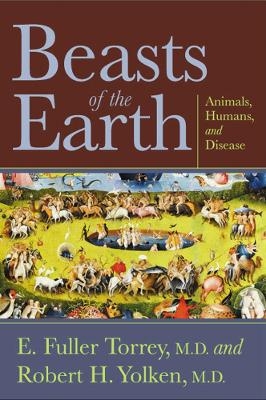
Beasts of the Earth
Rutgers University Press (Verlag)
978-0-8135-7143-0 (ISBN)
- Lieferbar (Termin unbekannt)
- Versandkostenfrei
- Auch auf Rechnung
- Artikel merken
Humans have lived in close proximity to other animals for thousands of years. Recent scientific studies have even shown that the presence of animals has a positive effect on our physical and mental health. People with pets typically have lower blood pressure, show fewer symptoms of depression, and tend to get more exercise.
But there is a darker side to the relationship between animals and humans. Animals are carriers of harmful infectious agents and the source of a myriad of human diseases. In recent years, the emergence of high-profile illnesses such as AIDS, SARS, West Nile virus, and bird flu has drawn much public attention, but as E. Fuller Torrey and Robert H. Yolken reveal, the transfer of deadly microbes from animals to humans is neither a new nor an easily avoided problem.
Beginning with the domestication of farm animals nearly 10,000 years ago, Beasts of the Earth traces the ways that human-animal contact has evolved over time. Today, shared living quarters, overlapping ecosystems, and experimental surgical practices where organs or tissues are transplanted from non-humans into humans continue to open new avenues for the transmission of infectious agents. Other changes in human behavior like increased air travel, automated food processing, and threats of bioterrorism are increasing the contagion factor by transporting microbes further distances and to larger populations in virtually no time at all.
While the authors urge that a better understanding of past diseases may help us lessen the severity of some illnesses, they also warn that, given our increasingly crowded planet, it is not a question of if but when and how often animal-transmitted diseases will pose serious challenges to human health in the future.
E. FULLER TORREY, M.D. is associate director for research at the Stanley Medical Research Institute in Bethesda, Maryland and a professor of psychiatry at the Uniformed Services University of the Health Sciences. He has authored or coauthored eighteen books, including The Invisible Plague: The Rise of Mental Illness from 1750 to the Present. ROBERT H. YOLKEN, M.D. is the director of the Stanley Laboratory of Developmental Neurovirology and a professor of pediatrics at Johns Hopkins University Medical Center. A specialist in infectious diseases, he is the coeditor of the standard textbook, Manual of Clinical Microbiology.
Contents
Acknowledgments ixIntroduction xi 1 The Smallest Passengers on Noah’s Ark 1 2 Heirloom Infections: Microbes before the Advent of Humans 14 3 Humans as Hunters: Animal Origins of Bioterrorism 23 4 Humans as Farmers: Microbes Move into the Home 33 5 Humans as Villagers: Microbes in the Promised Land 48 6 Humans as Traders: Microbes Get Passports 56 7 Humans as Pet Keepers: Microbes Move into the Bedroom 68 8 Humans as Diners: Mad Cows and Sane Chickens 97
9 Microbes from the Modern Food Chain: Lessons from SARS, In?uenza, and Bird Flu 11210 The Coming Plagues: Lessons from AIDS, West Nile Virus, and Lyme Disease 12411 A Four-footed View of History 139Notes 145Glossary 171Appendix 173Index 175
| Erscheint lt. Verlag | 30.9.2014 |
|---|---|
| Verlagsort | New Brunswick NJ |
| Sprache | englisch |
| Maße | 152 x 229 mm |
| Gewicht | 482 g |
| Themenwelt | Medizin / Pharmazie ► Medizinische Fachgebiete |
| Studium ► Querschnittsbereiche ► Epidemiologie / Med. Biometrie | |
| Studium ► Querschnittsbereiche ► Infektiologie / Immunologie | |
| Naturwissenschaften ► Biologie ► Zoologie | |
| ISBN-10 | 0-8135-7143-X / 081357143X |
| ISBN-13 | 978-0-8135-7143-0 / 9780813571430 |
| Zustand | Neuware |
| Haben Sie eine Frage zum Produkt? |
aus dem Bereich


